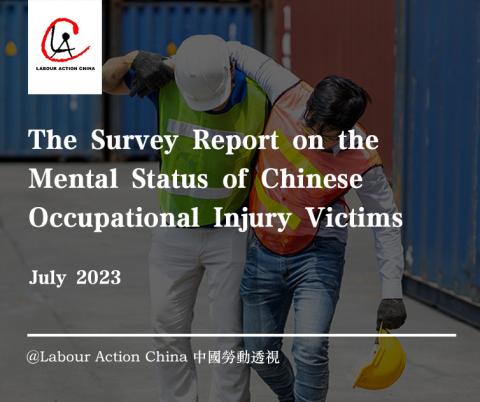
The Survey Report on the Mental Status of Chinese Occupational Injury Victims
Labour Action China
July 2023
[Click here to read more]
Since the economic reform, hundreds of millions of peasants have left their lands and surged into factories to work. Peasants’ lives have become workers’ lives accompanied by roaring machines everyday, but the ceaseless but ruthless machines devastate workers’ lives day by day. In China, as reported, 1.12 million workers were certified or assessed tentatively as occupational injury victims in 2020 in China. In other words, more than 3,000, on average, were hurt at work everyday. But it is sure that more victims have not been counted in.
Occupational injury, i.e., workers’ body injury at work, is the ‘dark side’ of industrial development in China. Since the 1990s, with the accelerated industrialisation and urbanisation of China, hundreds of millions of peasants have surged into cities and become industrial workers. Behind the so-called “Chinese miracle”, workers’ occupational health and safety have become more and more severe. Today, 30 years later, occupational injuries remain serious. The National Statistical Bulletin of Human Resources and Social Security Development shows that, in the last decade, more than 10 million workers have been certified or assessed tentatively as occupational injury victims in China.
According to academic studies, although there is a legal protection framework on occupational injury in China, victims’ access to their rights is still subject to various oppression by capital, power and policy during the daily operation of the legal protection and its policy-making. When workers get injured at work, they will face different difficulties including huge expenses in defending their legal rights, institutional restrictions, and limited social support. The difficulties are not limited to the legal practices to defend their rights, but also physical pain as well as mental sufferings and loneliness.
The partner in mainland, since its founding, has long been committed to serving the occupational injury victims by providing the victims various kinds of support, including access to legal resources, promotion of legal knowledge, assistance to the victims to identify their own rights, and mutual-aid network building.
The occupational injury victims are drawn into awkward situations with multifaceted challenges when they get injured at work. They need to bargain with enterprises, factories and public bodies to strive for the legal compensation. They also need to endure physical pains caused by body injuries and the feeling of being shamed and self-abased due to their disabilities. Many occupational injury victims are the breadwinner of their families, and their old parents and children can rely on them only. Loss of key income source devastates adversely the victims’ families. Moreover, most victims have had no hope about the future as they can hardly return to the job market due to their disabilities. Occupational injury victims experience stress due to the changes inside and outside themselves. In the face of the said difficulties, many victims share with the partner that “claiming compensation” has served as a clear goal upon which the victims can go through the whole compensation period and to overcome many problems later they will have to face, such as physical disability, unstable income, and precarious family relationship.
The partner has long provided legal assistance to occupational injury victims. Through its practical services, the partner finds that it is immerse of importance and urgency in providing mental support to the victims. This study aims to understand the mental status of occupational injury victims and to explore appropriate services to the victims on their psychological needs. The study is composed of a standard questionnaire with random sampling and individual interviews. All the subject sample were the occupational injury victims who have received services by the partner. The victims were selected by random to fill in the questionnaire. Follow-up interviews could be conducted based on the answers of individual victims. The interviews aimed to have comprehensive understanding about the mental status of individual victims after injuries.
In total, 78 valid responses to the questionnaire were collected. According to the IP addresses of the respondents, 77% of them came from the Pearl River Delta region, 9%, from the Yangtze River Delta region, and the remaining 14%, from the neighbouring cities of the Pearl River Delta and the Yangtze River Delta. The questionnaire consists of three parts: personal information, mental status of the victims, and support from outside. In addition to the questionnaire, interviews were conducted to supplement additional information or to study individuals’ answers deeply. In the end, the study may provide guidance and recommendations for better and more appropriate servicers to occupational injury victims.
The study is limited by the design of the questionnaire and the methodology of the study. Although the study cannot bring us a comprehensive picture about the mental status of occupational injury victims, the data collected can serve as a reference for understanding the mental status of occupational injury victims.
